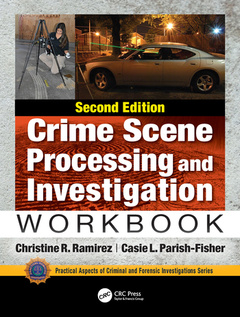Description
Crime Scene Processing and Investigation Workbook, Second Edition (2nd Ed.)
Authors: Ramirez Christine R., Parish-Fisher Casie L.
Language: English
Subjects for Crime Scene Processing and Investigation Workbook...:
Keywords
Gelatin Lifter; Fluorescent Scale; forensic science; Examination Quality Photographs; criminal justice; Friction Ridge Skin; crime scene analysis; Crime Scene; crime scene workbook; Bloodstain Patterns; forensic science lab activities; Footwear Impressions; CSI workbook; Crime Scene Personnel; investigation; Crime Scene Processing; fingerprint analysis; Evaluation Worksheet; murder; Scene Investigation; homicide; Evidentiary Items; search pattern; Data Worksheet; missing persons; Bloodstain Pattern Analysis; trace evidence; Livor Mortis; toolmarks; Shutter Speed; toolmark examination; Als; crime scene photography; Crime Scene Reconstruction; blood spatter; Primary Focal Point; Tape Lifts; shooting incidents; Crime Scene Report; CSI Effect; footwear impression evidence; Dental Stone; Sticky Side Powder; Event Segments
45.15 €
In Print (Delivery period: 14 days).
Add to cartPublication date: 01-2020
· 21x28 cm · Paperback
135.96 €
In Print (Delivery period: 14 days).
Add to cartPublication date: 01-2020
· 21x28 cm · Hardback
Description
/li>Contents
/li>Readership
/li>Biography
/li>
Crime Scene Processing and Investigation Workbook, Second Edition is the only workbook which directly supports and cross-references methodology and terminology presented in Ross Gardner and Donna Krouskup?s perennial best-seller Practical Crime Scene Processing and Investigations, Third Edition. The workbook serves as supporting material offering hands-on activities to supplement theories and methodologies within the text as well as updated activities to support the new material presented in the Third Edition.
As the number of forensic academic programs within the United States continue to grow?and the textbook continues to be a go-to standard in the field?the workbook remains an invaluable reference for academics, forensic training providers, and law enforcement training programs. The detailed Instructor?s Manual (IM) lends itself not only to experts who have utilized these procedures before but also to the novice and student who may be introduced to these topics in a classroom setting for the first time. The workbook conducts over 30 activities with detailed instructions, concept overviews, and reflective post-lab questions. Crime Scene Processing and Investigation Workbook, Second Edition, continues to stand as the best workbook on the market, addressing foundational principles in a hands-on manner while directly correlating to the concepts addressed in the Gardner and Krouskup textbook.
Chapter 1 Introduction
Chapter 2 Understanding the Nature of Physical Evidence
Chapter 3 Actions of the Initial Responding Officer
Chapter 4 Crime Scene Processing Methodology
Chapter 5 Assessing the Scene
Chapter 6 Crime Scene Photography
Chapter 7 Crime Scene Sketching and Mapping
Chapter 8 Narrative Descriptions: Crime Scene Notes and Reports
Chapter 9 Basic Techniques in Crime Scene Processing - Light Technology
Chapter 10 Basic Techniques in Crime Scene Processing - Recovering Fingerprints
Chapter 11 Basic Techniques in Crime Scene Processing - Casting
Chapter 12 Shooting Scene Documentation and Reconstruction
Chapter 13 Bloodstain Pattern Analysis
Chapter 14 The Body as a Crime Scene
Chapter 15 Special Scene Considerations
Chapter 16 Crime Scene Analysis
Christine R. Ramirez is the coordinator of the Texas Forensic Science Academy within the Texas A&M University System’s Texas Engineering Extension Service in College Station, Texas. She is an active instructor of crime scene investigation, evidence processing, friction ridge development, and bloodstain pattern analysis. She has developed forensic science courses and served as a subject matter expert for forensic science training manuals. Ms. Ramirez served as the senior crime scene investigator in the crime laboratory of one of the largest sheriff’s offices in Texas. She currently holds a Master Peace Officer license from the state of Texas, with seventeen years of investigative experience. She is a Certified Senior Crime Scene Analyst by the International Association for Identification and is a court-qualified expert in bloodstain pattern analysis and latent print examination. She graduated from Sam Houston State University with a Bachelor of Science degree in Criminal Justice. Ms. Ramirez is a member of the International Association for Identification, Texas Division of the International Association for Identification, and International Association of Bloodstain Pattern Analysts.
Casie L. Parish-Fisher is currently assistant professor of forensic science in the Bachelor of Science Degree Program at St. Edward’s University, Austin, Texas. She graduated from Baylor University with a Bachelor of Science degree in forensic science. She completed her Master’s of Science degree in DNA profiling at the University of Central Lancashire, Preston, England, and is currently matriculating on her PhD in research topics relating to DNA analysis. She is coeditor of a sui generis anthology titled Pioneering Research in Forensic Science (Lewiston-Queenston-Lampeter: Edwin Mellen Press, 2009) with colleagues from St. Edward’s University, Dr. David M. Horton and instructor Michelle Y. Richter. She is a member of the International Association for




